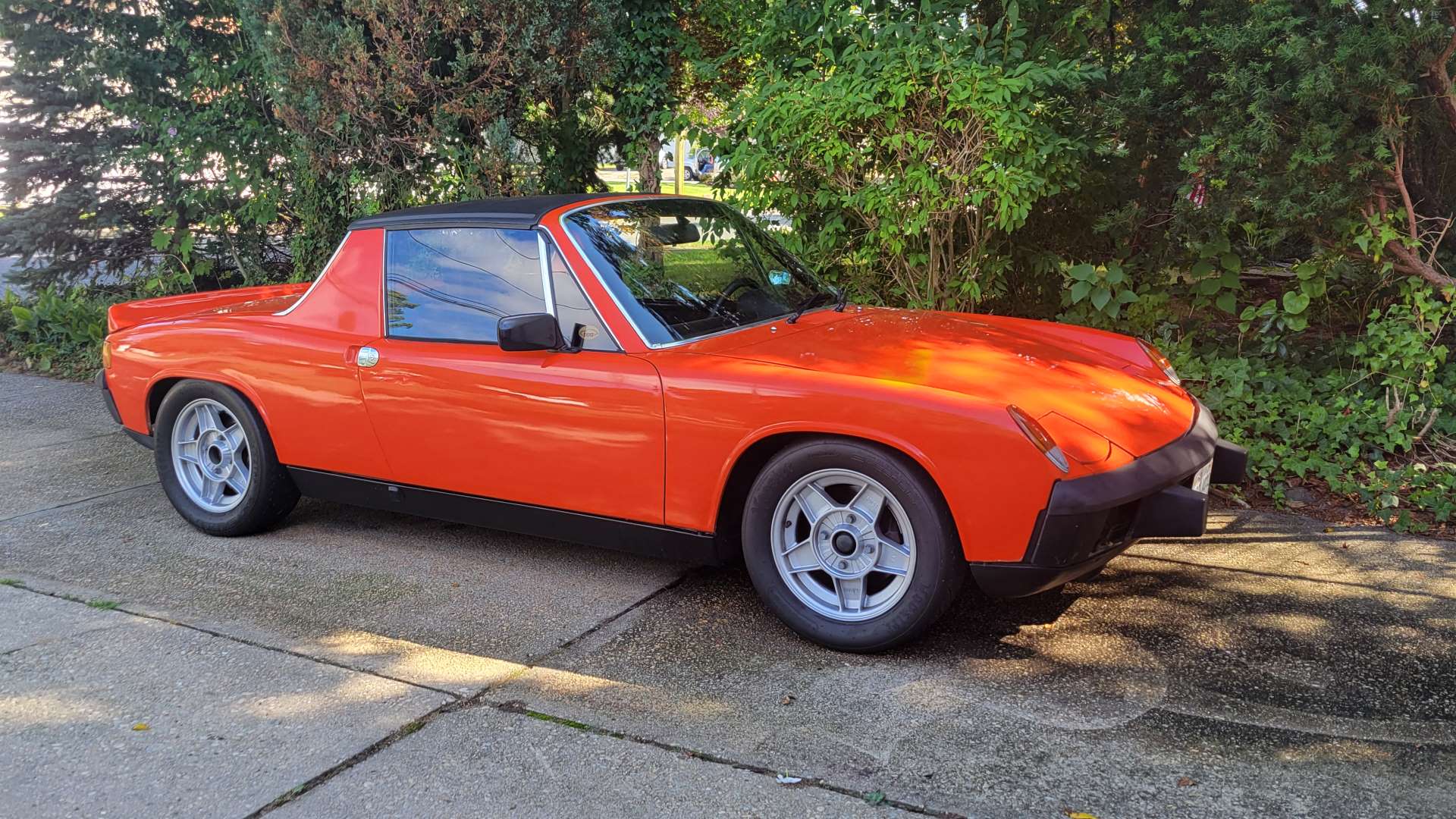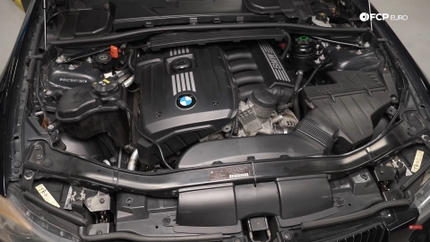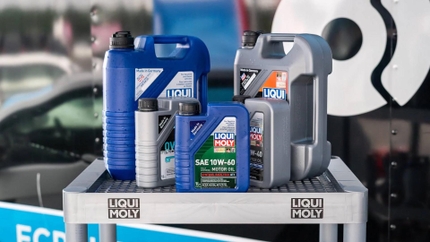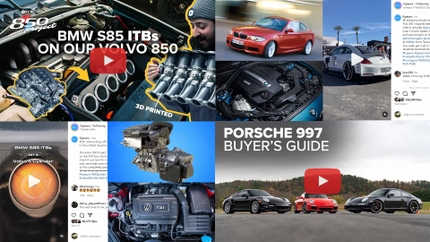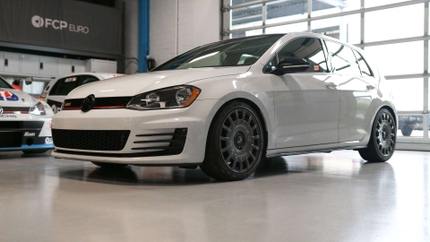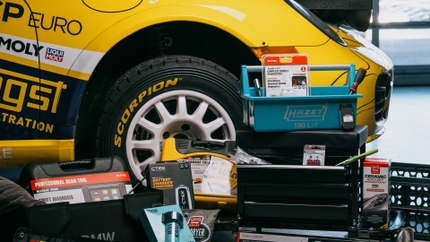2022 has been the best year on record for EV sales and offerings by a significant margin, and that’s only poised to improve next year. Batteries are getting lighter, ranges are getting longer, and carmakers are finally putting out complete offerings in several body styles and price points—all great things for the consumer. This year specifically, several automakers will debut their larger EV SUV models in an attempt to establish luxury EV domination. It will be a year dedicated to moving people, with some exciting options to choose from.
Audi A6 e-tron
Audi released its first e-tron-badged model in the states around 2016 and has been steadily releasing new EVs ever since. The enthusiast-targeted super-sedan e-tron GT and the family-oriented e-tron SUV have proven the legitimacy of the EV market and spurred Audi’s continued development. Now the EV powertrains have spread to the sedans, specifically the A6. Already one of the better European sedans you can buy, the A6 e-tron is set to take the classic nameplate up to the forefront of automotive engineering.

Although the production-ready variant has yet to be released, Audi has been relatively candid about its proposed specs and performance. The basis for the new EV is Volkswagen Group’s PPE platform, breaking any mechanical link to the standard A6 built on the MLB Evo platform. Co-development between Audi and Porsche, a 100kWh battery pack sits at the center of the chassis forming a stressed member and the vehicle’s floor. From there, the A6 e-tron’s trim specifies whether it’s rear-drive or all-wheel-drive.
Being an EV, the number of motors determines the power output, but much of the architecture is common between variants. The electrical architecture will be the same 800-volt system from other e-tron models, making the A6’s charge times similarly quick. Audi quotes a 25-minute charge to go from 5% to 80%. They also gave estimated power figures for the dual-motor variant; 469 hp and 590 lb-ft of torque over an estimated 300+ mile range on the EPA test circuit. The e-tron GT received only a 232mi range from the EPA, so the A6 should show just how quickly gains are being made in battery and efficiency tech.
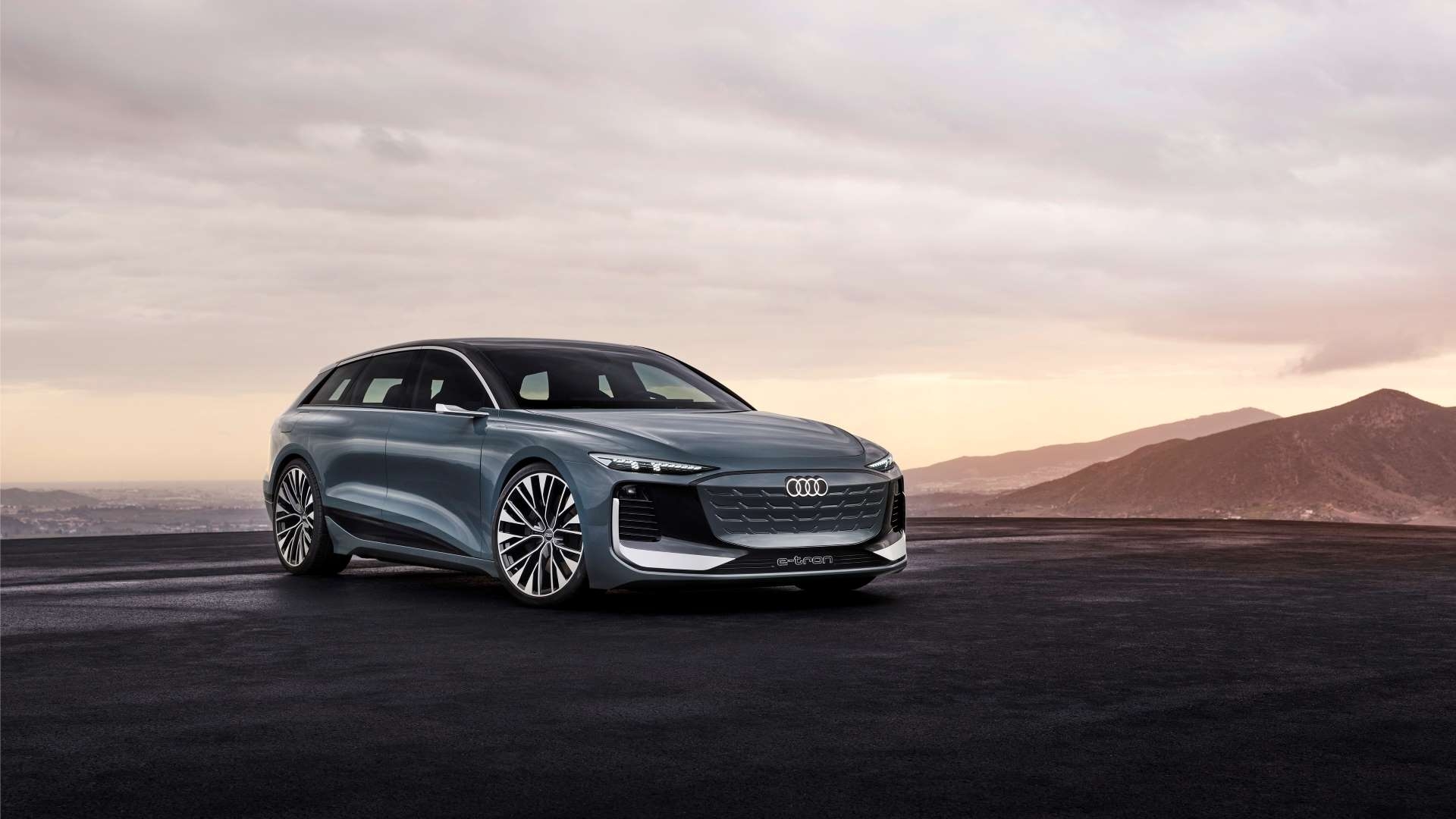
Part of that range can be attributed to the A6 e-tron’s body, which carries a 0.22 coefficient of drag, just .02 away from the EV-leading Mercedes EQS. The sleek e-tron styling is in line with other EV models and should look quite different from the ICE-A6, which will remain in production alongside the e-tron for at least a few years. Initial concept unveilings showed off a traditional sedan with contemporary ICE proportions but futuristic EV-like front and rear fascias. The long hood and cabin positioned rearward on the chassis aren’t necessary without an engine under the hood. Still, it keeps the public interested as many aren’t yet ready to part ways with traditional design language. Earlier this year, Audi event released images of an A6 e-tron Avant, hinting that the long roof will help in warming up the idea of an EV to the automotive enthusiast.
While there isn’t a confirmed release date for public consumption, Audi has confirmed that it will arrive in 2023, likely as a 2024 model year. Photographers have taken snaps of prototype vehicles as recently as November 2022 with production-ready lighting appearing through the camouflage, though they aren’t as radical as the concept pieces. When it reaches the dealerships, expect it to carry a price tag similar to the current A6, around $57,000.
Volvo EX90
Volvo’s first foray into the SUV market was an enormous success for the Swedish automaker. Their XC90 was a quick hit among buyers, selling well even after a decade on the market. By the time the second generation model arrived, Volvo’s plans for an all-electric future were in motion, priming the company to expand its market share as the eco-friendly luxury automaker. Half a decade later, the third generation arrives on a modular electric platform to fly the flag for the brand’s near future.

The range-topping SUV will be the second to arrive on the new SPA2 platform shared with Volvo’s sister company, Polestar, sporting updated design language and new tech. Like other EVs, the modular platform will allow variance in the lineup between motor count, seat count, and battery size and performance. Currently confirmed are two twin-motor trims powered by a 111kWh battery on a 400-volt system. The “performance” E2 trim is specified to have 469hp and 671 lb-ft of torque between its two motors which should lend well to potential tow duties and straight-line speed. How well that electricity fares when it comes to the range they aren’t entirely sure yet, but Volvo expects it to come in just under 300mi.
Styling-wise, this generation of Volvo products is one of the strongest we’ve seen in recent years, and the EX90 follows that, almost to a fault. The overall body shape remains the same, but accenting details have gone from round to sharp, like on the beltline, while the mirrors, window trim, and door handles were all streamlined to make the big SUV as aerodynamic as possible. Up front, the Thor’s Hammer headlights remain a popular and stylish feature, but the nose as a whole looks indistinguishable from Volvo’s smaller models. The current gasoline-powered XC90 has a certain luxurious and elegant presence that the redesign swaps for digital minimalism. The same can’t be said about the rear, though. The new take on the traditional taillight feels smart and advanced in all the right ways.
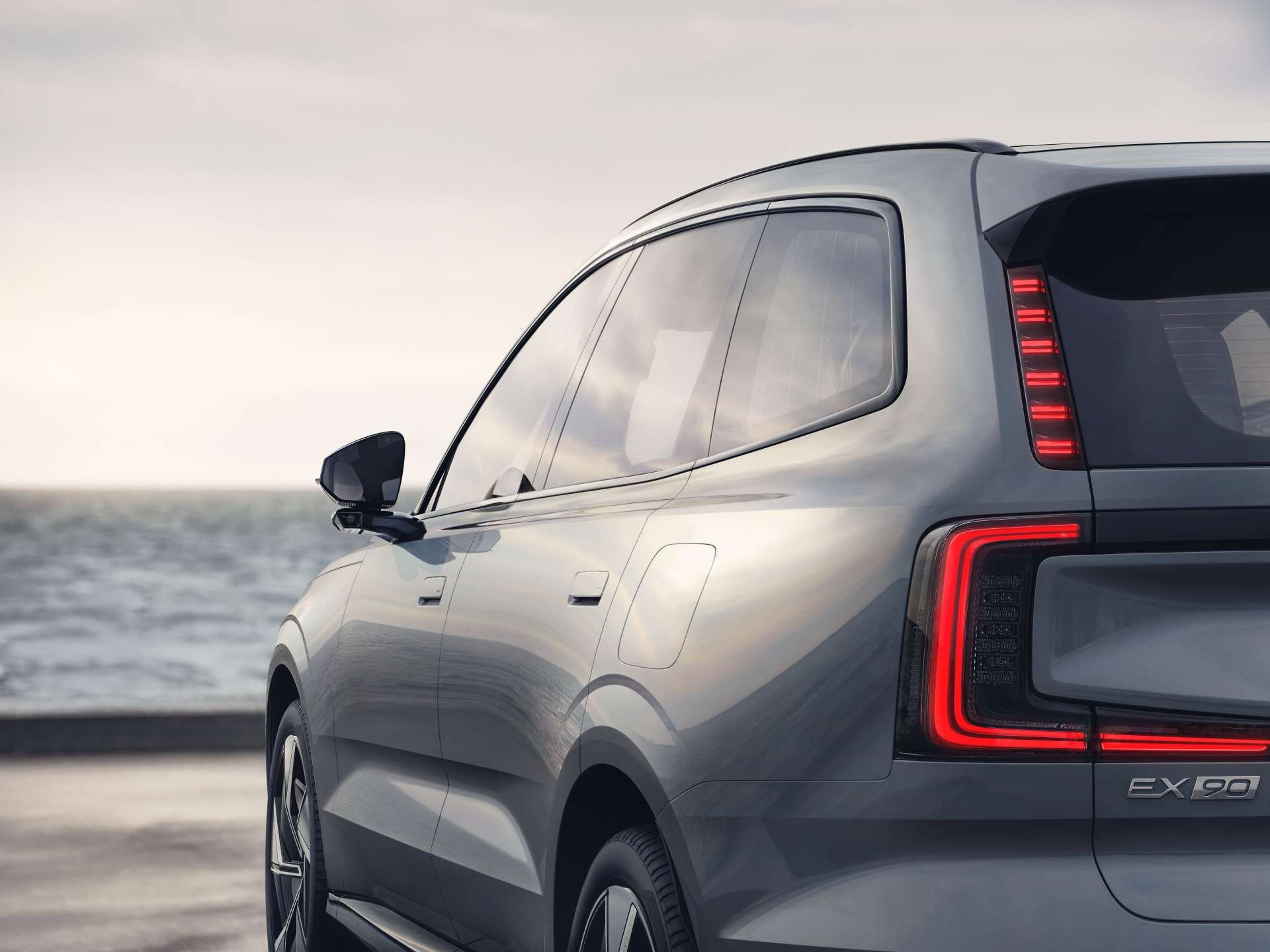
Inside the EV, the current Volvo layout is beautiful in its minimalism. Metal trim accents wood grain and leather upholstery and is accompanied by two large screens making up the instrument cluster and infotainment system. New for the EX90 is the inclusion of Dolby Atmos, a 4D 360-degree sound software playing through a 25-speaker Bowers & Wilkins audio system. Seating upholstery is made from a wool blend, highlighting the sustainable efforts put into creating the EX90. Along with 15 percent of its plastics formed from recycled materials, it uses 15 percent recycled steel and 25 percent recycled aluminum to reduce waste.
Of course, it wouldn’t be a Volvo without some killer safety features, too. The entire range of sensors, cameras, and Lidar are present under the Pilot Assist system. When asked, the Volvo can accelerate, stop, and change lanes on its own through those accessories and its operating system. All of that comes in a traditionally well-built package set to cost right about $80,000. Not too shabby, considering Volvo’s solid record with EVs and the amount of technology crammed into the seven-seater. Single motor variants will likely cost less, as will future five-seat versions.
Polestar 3
For decades, Saab and Volvo fought back and forth over who had the most Swedish offering. Saab may no longer be with us, but Volvo arm Polestar is here to take its place. The company has been around for a while as Volvo’s tuning branch and motorsports division, but the shift to electric vehicles saw the tuner evolve into a luxury sub-brand. For 2023, the Polestar is debuting its third model, the aptly named 3, a mid-size SUV based on the same SPA2 platform as the Volvo EX90. Are these two just the same model, or are there significant differences?
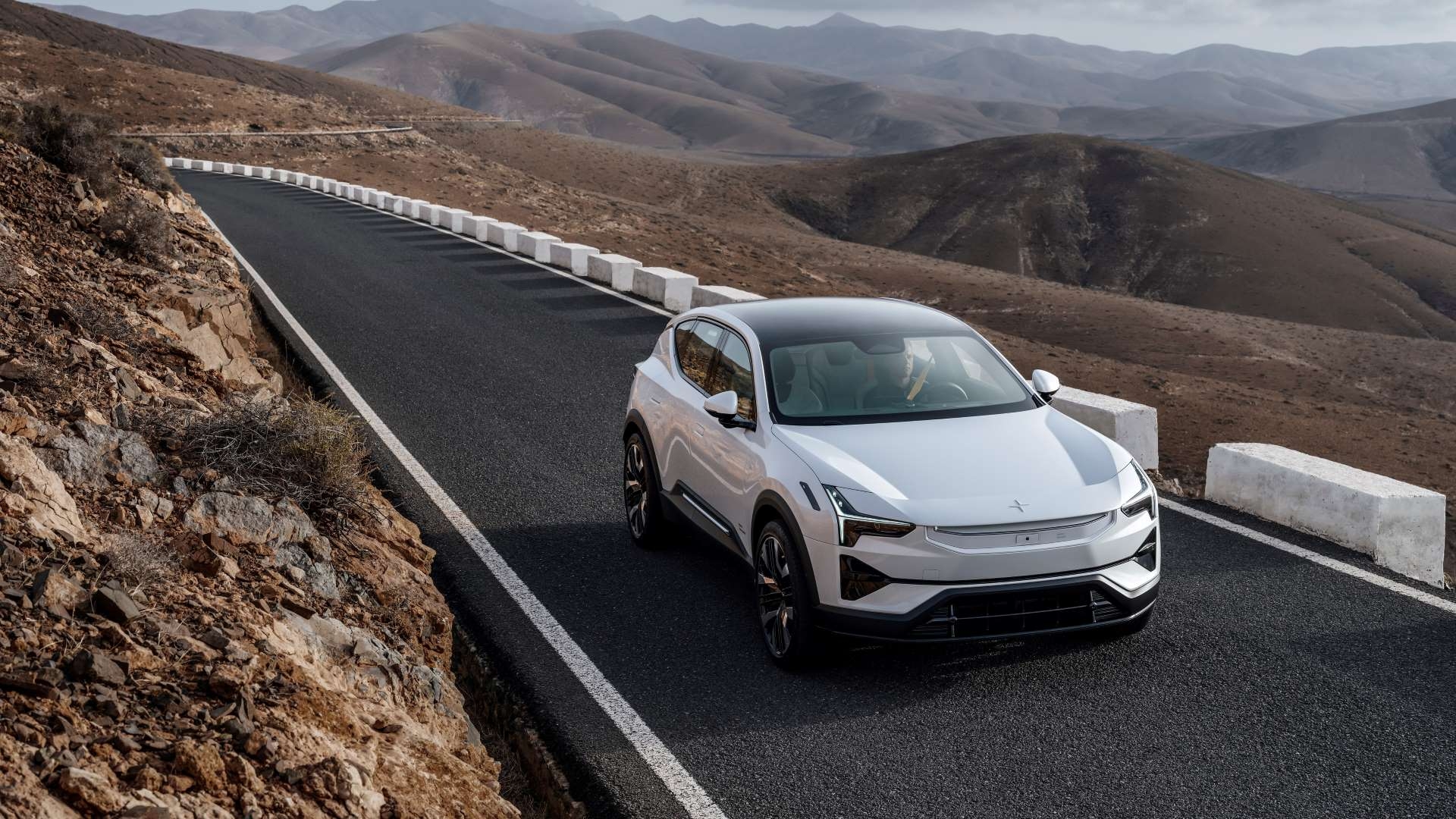
Under the skin, the two models couldn’t be more similar. The only available battery at launch is the 111kWh unit fitted to the dual motor models. In base long-range dual-motor spec, an estimated 300mi range comes with about 480 horsepower and 620 lb-ft of torque, good enough for a 4.9s sprint to 62. Add another $6000 to the base car’s $83,900 starting price, and you’ll get the Performance Pack. Range is shortened by 30mi, but peak power figures are up to 510hp and 670 lb-ft, with a 4.6s run to 62mph. When the road gets bendy, the 3 isn’t in its preferred element, but the electric Torque Vectoring Dual Clutch function on the rear axle and adaptive dampers ensure the bends are handled without a fuss.
Inside the cabin, it’s much of the same as the EX90. The dashboard, seats, center console, and infotainment are all the same design. The difference comes from the specific upholstery—bio-attributed MicroTech, animal welfare-certified leather, and fully traceable wool upholsteries—and trim colors. Adding to similarities, every 2023 model will also receive the Pilot pack and Plus pack. The former focuses on driving enhancements like Pilot Assist, a heads-up display, and adaptive cruise control with lane-centering. The Plus pack adds more luxurious touches like a change in upholstery, 21″ 5-V spoke black diamond cut wheels, soft-closing doors, and a 25-speaker Bowers & Wilkins stereo.
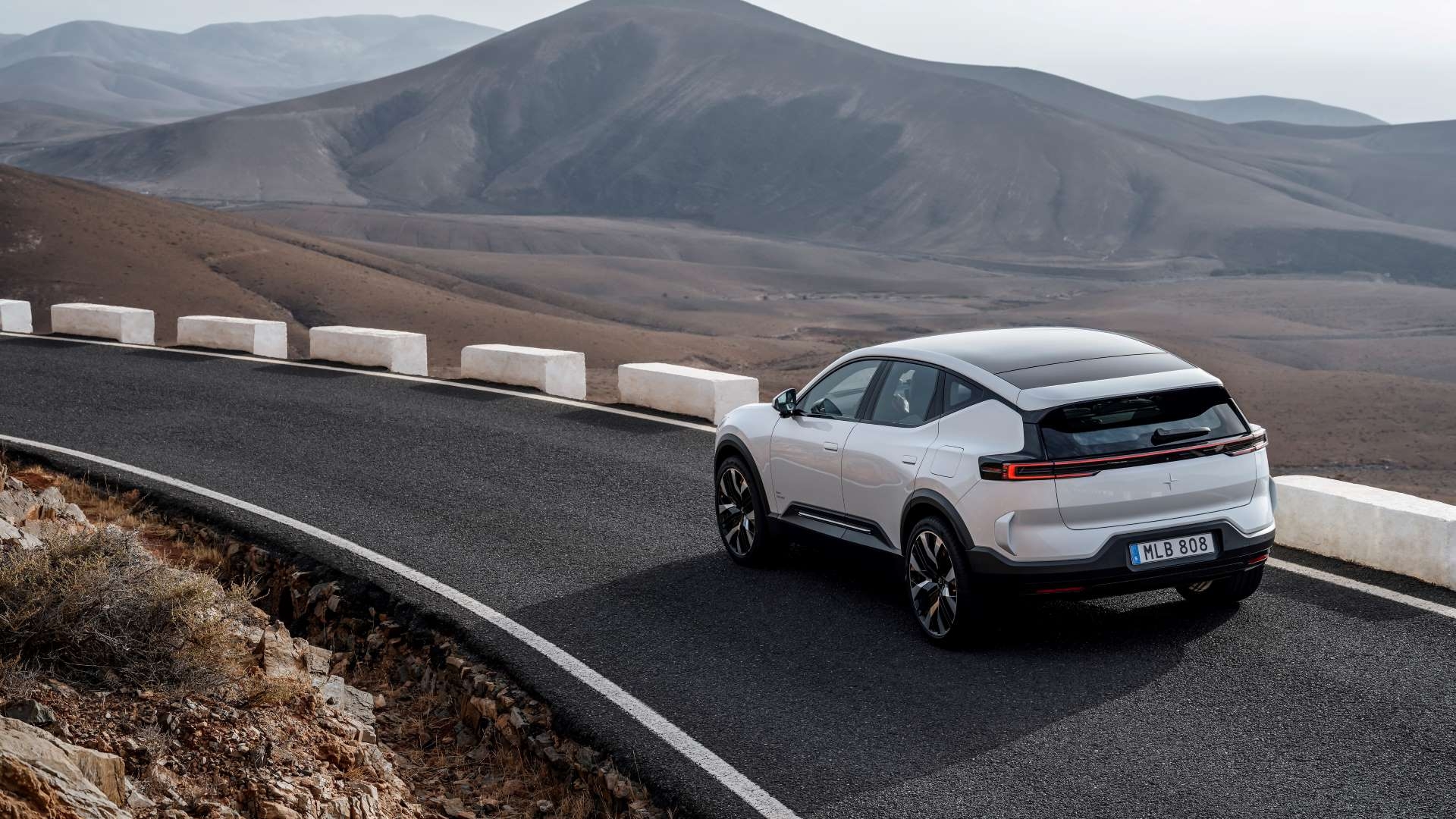
The only large difference between the two is the exterior, which is very much a good thing. Where the EX90 is relatively reserved, the 3 is a striking and chiseled take on the family hauler. The front fascia is far busier than the Volvo, with a Mercedes C11-style front wing stuck between the “Thor’s Hammer” headlights. The hood is slung low in the center but rises on either side to meet the raised fenders. Along the side, black plastic cladding guards the lightly flared wheel wells and raises up slightly along the doors to tighten the 3’s beltline. Thin rectangular taillights are connected by a light bar; admittedly, they look pretty Volvo, but that isn’t bad. Overall, it’s truly unique looking in an age where most models blend together, and it might just be the best-looking EV SUV to date.
VW ID. Buzz
Truly very few vehicles are more iconic than Volkswagen's Type 2, affectionately known as the Bus. The humble van began as an affordable way to move people around. Still, it became the face of a counterculture movement in America, a roaming home for others, and occasionally the vehicle of choice for terrorists looking to get their stolen Plutonium back from some doctor with a DeLorean. Its popularity faded at different times in different places, and the world has been without it for a couple of decades, but the nostalgia for it has come on strong since then. Yesterday's counterculture is today's vintage, and Volkswagen has just the right product, an all-new, all-electric Bus.
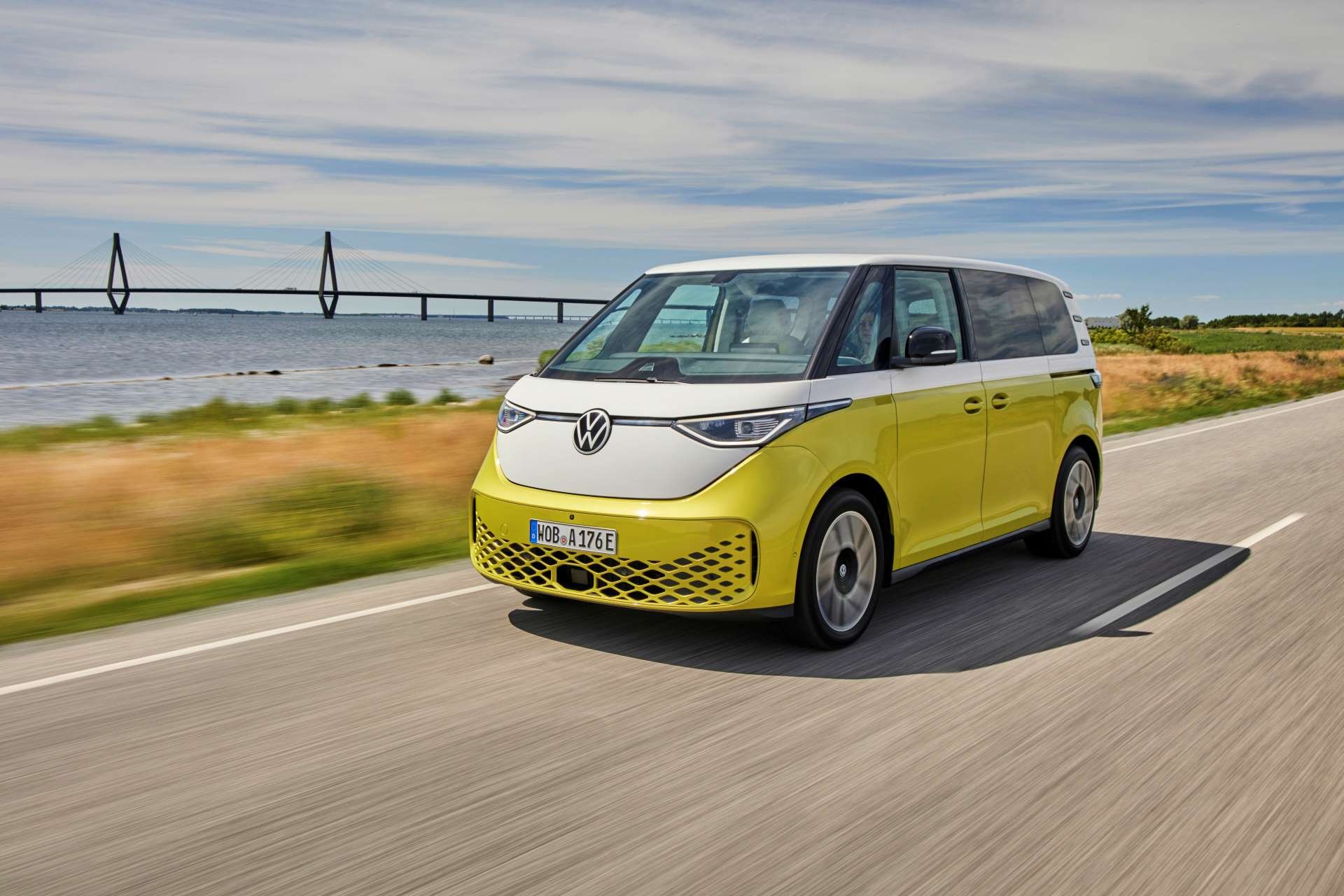
In the spirit of the original, the Buzz isn't just a people mover but a cargo hauler. VW sells a passenger variant and a commercial one depending on your needs. They're essentially the same van, using the same chassis and drivetrain, but the interior is different and suited to the customer's specific needs. Powering them is a 77kWh battery pack in the floor that spins a single motor on the rear axle—power figures peak at 201hp and 229 lb-ft of instant torque. Ranges are nearly identical; the Buzz achieves 263mi, and the Buzz Cargo comes a mile more. In a straight line, the 10.2s to 62mph isn't tremendous and likely one of the slowest you can get your hands on new, but that isn't what the ID.Buzz is about.
The old VW Bus was achingly slow, but people loved it for its design, charm, space, and useability, all of which the ID. Buzz has. Most noticeable is the retro design with its optional two-tone paint and giant VW logo on the "v-shaped hood." To VW's credit, the Buzz looks hardly unchanged from the initial concept unveiled in 2017, a statement that can't be said of many concepts that made it to production. The goal was to evoke the original design, and it's safe to say that VW hit its marks without overdoing it. Necessary safety components like LED lights, parking sensor arrays, and cruise control radar blend in seamlessly, adding modern touches to the retrofuturistic ride.
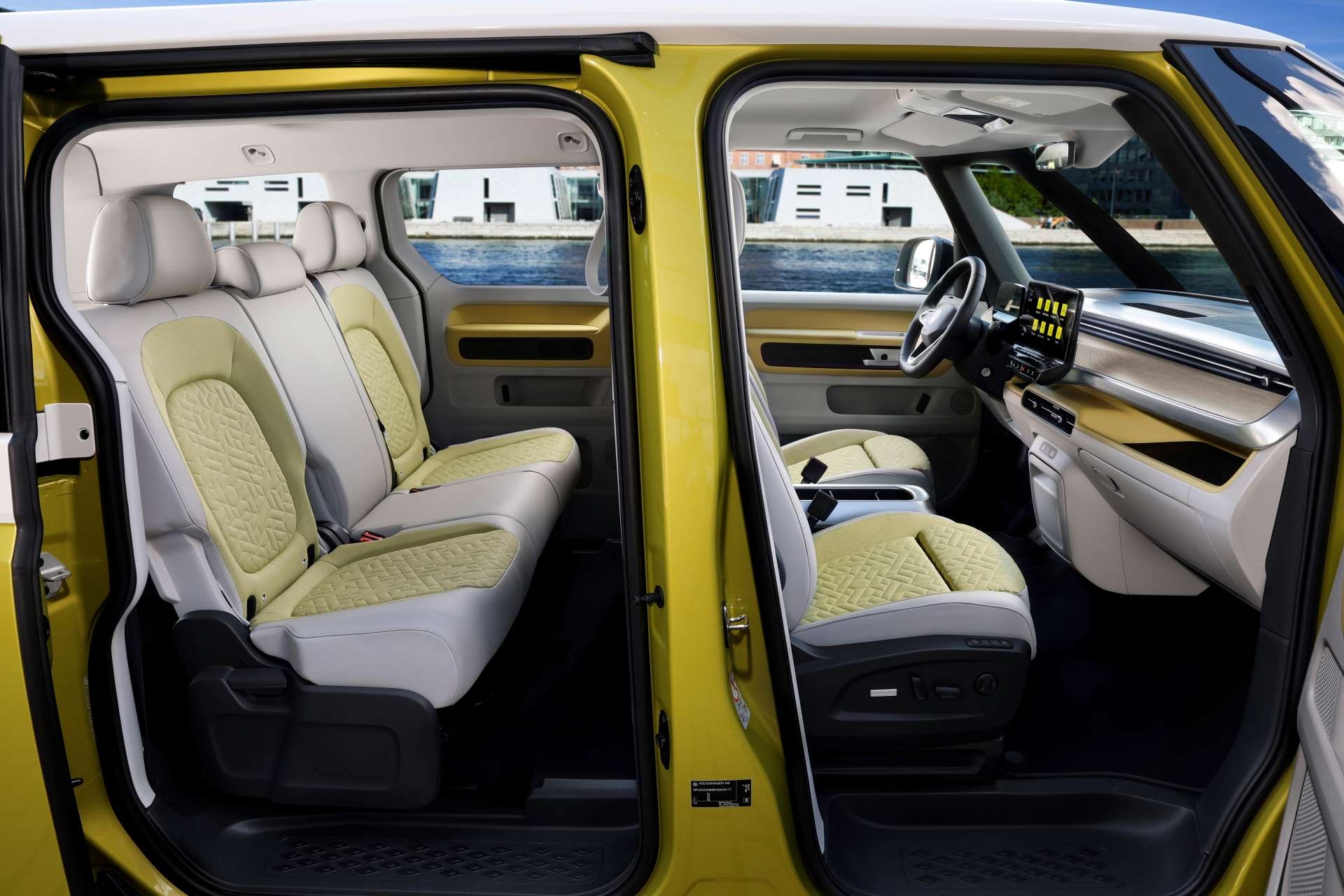
Inside, the Buzz is all in on the 60's flair and carries the values those colorful people did back in the day while still providing the creature comforts we expect. The fun, paint-matching two-tone seat and door panel upholstery is made of recycled ocean plastic and PET bottles to reduce its environmental impact. Passengers have eight USB-C charging ports, and the front seats get a massaging feature in top trim. Infotainment and driver display is handled by a 10-inch and 5.3-inch display, respectively, through the standard "Ready 2 Discover" software. The optional "Discover Pro" features a larger 12-inch screen. Safety features are plenty, too. The advanced Car2X, Front Assist with pedestrian and cyclist monitoring, and PreCrash occupant protection are standard, while the Pro trim includes Dynamic Road Sign Display and Lane Assist.
As long as VW works out any kinks before owners start driving them in late 2023, the Buzz will surely be a hit. It's a perfect modern interpretation of all the original's beloved qualities while offering the EV lifestyle and modern tech most are looking for these days. Factor in the estimated $40,000 starting price, and there's no doubt that a suburb near you will soon have one silently driving around.
Mercedes-Benz EQE SUV
The newer EV models leaving Stuttgart with a Mercedes badge have had some mixed reviews in the styling department. The ultra-slippery shape of the EQS and EQE sedans did away with the traditional “three-box” configuration to maximize aerodynamic efficiency, and it worked, but not without detractors criticizing them for their awkwardly round appearance. Coming in 2023 as an alternative to those sedans are their larger siblings designed for taller seating positions and a bit more space in the back. We know Mercedes can build a great gasoline-powered SUV, but how about an electric one?
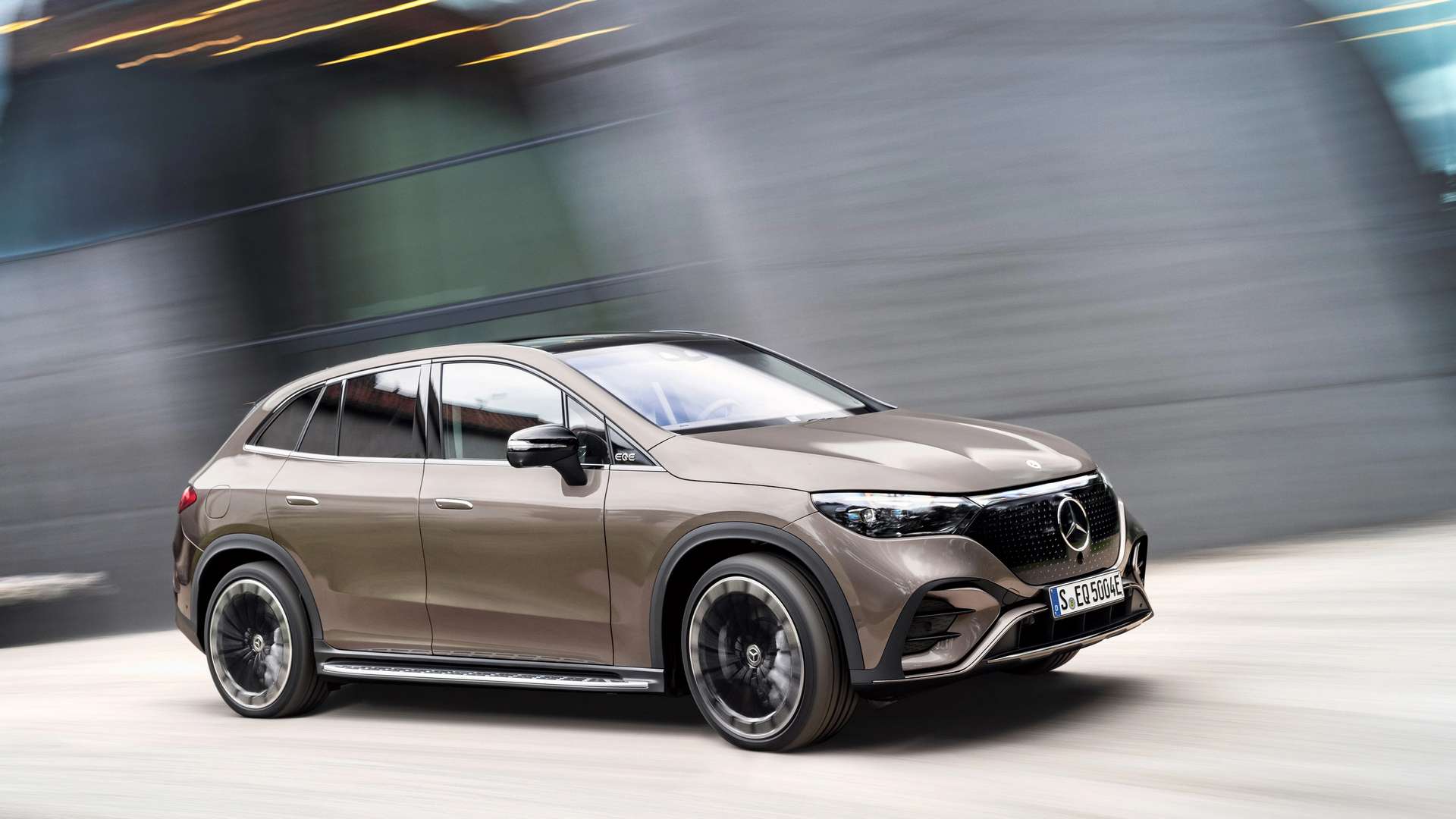
Personal styling opinions aside, the Mercedes EQE and EQS sedans have received good marks for their driving feel and electric powertrain. The EV2 platform they ride on provides that classic Mercedes comfort while giving the company a modular base to spawn new models, like the EQE’s SUV variant. Under the skin and without the lifted suspension, the two EQEs share a battery and electric motors. The base model EQE350+ features a single motor and a 90.6kWh battery pack that offers 288hp and 417 lb-ft of torque to the rear wheels. Stepping up to the EQE350 4Matic adds another motor onto the front axle, but only torque jumps up to 564 lb-ft. Up one more level is the EQE500, a dual-motor variant producing 402hp and 633 lb-ft of torque from the same battery. The maximum range for the single-motor 350+ is an estimated 305mi, but the dual-motor variants will fall shorter thanks to their weight and performance penalties.
The new model’s chassis comprises of a four-link suspension at the front and an independent multi-link suspension at the rear. A passive damper and spring setup is the standard suspension offering, but the optional AIRMATIC with an ADS+ adaptive air suspension system is highly recommended. Like other Mercedes products, the ADS+ allows drivers to soften or firm up their dampers, but only the dual-motor SUV models receive an additional OFFROAD setting for an extra inch of ground clearance. Assisting the SUV’s agility is its 3.5” shorter wheelbase over the EQE sedan, and buyers can further improve it with the optional rear-wheel steering. Don’t expect AMG GT levels of maneuverability, but the EQE SUV should get around without falling over itself.
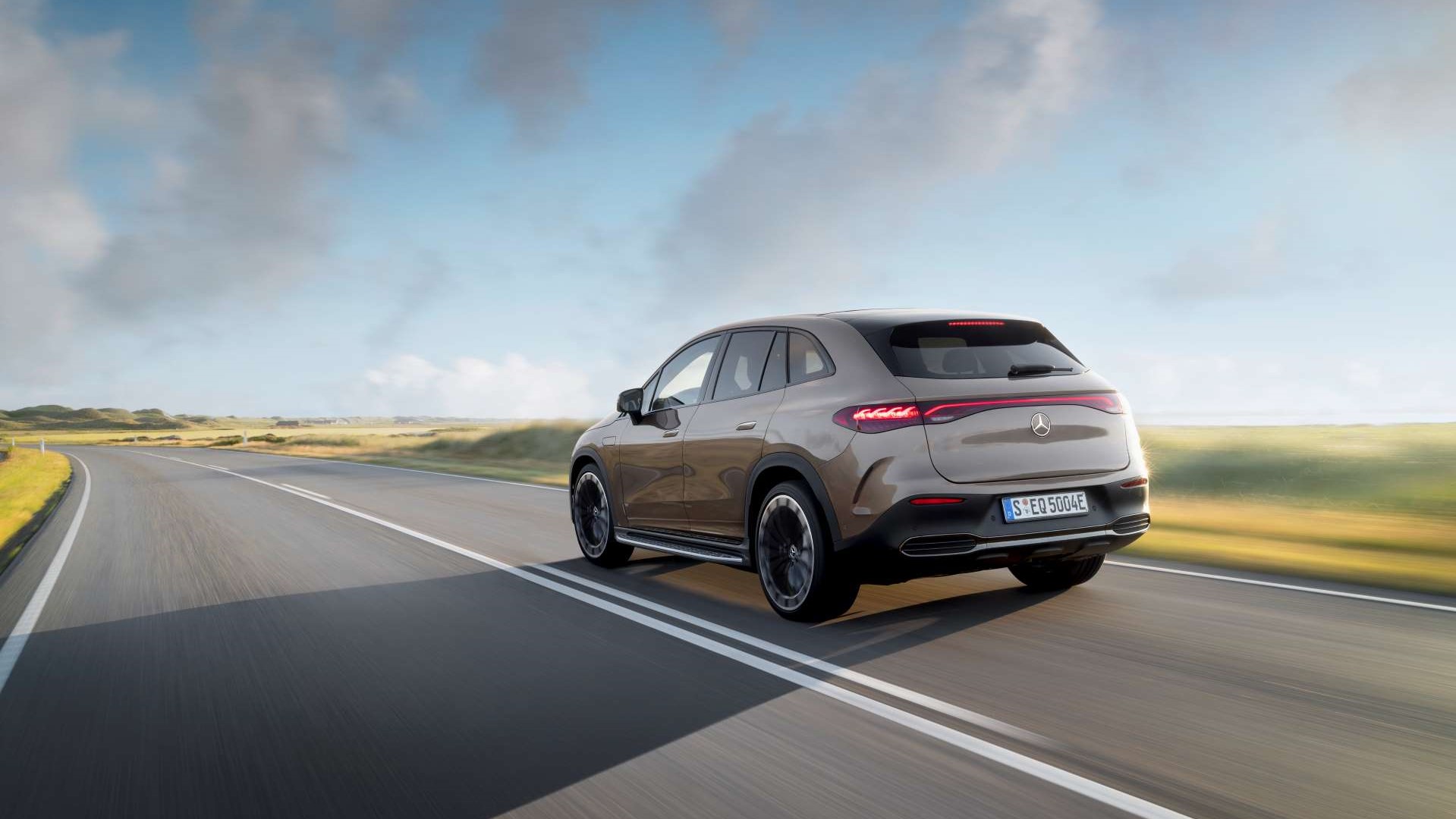
Open up the EQE, and you’re met with a classically luxurious Mercedes package. While smaller than the EQS, its cabin is just as roomy, with enough space for adult passengers in the front and rear. Standard upholstery is synthetic leather derived from recycled materials; the front seats they cover are heated. A panoramic glass roof and an extensive ambient lighting setup help deliver the rest of that luxury feel, but there are plenty of extras you’ll want, too. Four-zone climate control should eliminate any turmoil from your children in the back seats arguing over how high the heater is set, but if not, the massaging seats should help bring down your blood pressure.
Available with some criticism from many reviewers is the MBUX Hyperscreen, which turns nearly the entire dashboard into an infotainment screen. It’s unique, but response times aren’t the quickest. A 12.8” infotainment screen connected is standard, and both connect to a Burmester sound system operating with Apple CarPlay and Android Auto. The most important standard features are the safety-related items, like automated emergency braking and lane-keeping assist, but “fancier” things, like Evasive Steering Assist and Active Lane Change Assist, are reserved for an optional Driver Assistance package.

Perhaps the most encouraging bit for Mercedes is that the EQE SUV sheds most of the blob-like sedan proportions. It isn’t perfect, but the greenhouse is much more natural looking, helping the rounded front end appear less bulbous. The rear-end treatment is a little more polarizing, but it fits in line with other Mercedes products. Altogether, it seems like the revised styling of the SUV and the general public’s obsession with them will prove to be a big driver of EQE sales soon. The nearest competitor is the Tesla Model X, so Mercedes shouldn’t have much competition. Only time will tell, but prepare yourself to start seeing these SUVs with some regularity.
The Eco/EV push is necessary for the survival of the GT3s, AMGs, and M3s of the world, but it’s also an incredible time for enthusiasts as a whole. It’s been over a century since we’ve had the automotive landscape reshaped by a new technology that has allowed startups to compete quickly with the big manufacturers. As they push boundaries, our favorite Euro manufacturers are all pushing to keep up. Competition is a good thing, and we’re all gonna benefit from it, starting with these soon-to-be models. Thanks for reading, and follow along on our blog and subscribe to our YouTube channel for more great DIY and entertainment content.

